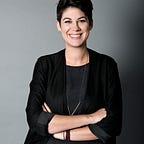The Disruptive Design Method for Activating Positive Social Change
For the last decade, I have focused my career on figuring out how to use design as a catalyst for positive social and environmental change — it’s been a constantly-evolving journey, involving many knowledge quests and fascinating experiments into how to make change in the world. As a result, I’ve developed the Disruptive Design (DD) Method, a three-part process of mining, landscaping, and building systems interventions that effect change. Over the last two years, I’ve been teaching the method to creative rebels and change agents around the world, through the UnSchool, and today I’m excited to share it with you all, through the release of the Disruptive Design Method Handbook.
Clearly, I like a good construction metaphor, but it’s more than that. I use these terms — mining, landscaping and building — to define three phases of an interactive and evolving approach to systems intervention design, as they have the power to evoke the mental schemas of action and participation (rather than passive observance).
If you conjure a mental image of the verb mine, you get to the visual understanding of diving deep into something and pulling things out. Hear the word landscape and you may think of a beautiful terrain, which you can look out at, taking in the lay of the land — perhaps even from a bird’s eye view, in which case you’d get the full perspective of what’s going on in that system. The word build should provide the visual reference of a building being constructed, or even a cityscape in flux. In the DD Method, these three phases are iteratively cycled through to get to an intervention that challenges the status quo of a problem arena.
Through thousands of hours of teaching sustainability, design, and innovation, I’ve discovered that most people deflect responsibility for changing the world to the big obvious parts of the system, like education or government. These ‘top of the iceberg’ nodes are the obvious parts of the system, so it’s easy for people to jump right to them, casting blame and framing them as beyond their personal control. With something “beyond control” to blame, one can carry on guilt-free, ignoring the issues, because it’s someone else’s responsibility to change the big system issues, right?
Wrong. This is basically a bullshit, lazy-brain avoidance tactic that our poor under-equipped brains use as a way of getting through life. We have a significant crisis of agency and an even bigger knowledge-action gap on our hands. Highly-skilled people are not investing their creative intelligence in addressing the real and significant problems at hand. But, actually we all have the capacity to actively participate in the construction of the type of world we want to live in.
Designer or not, the Disruptive Design Method is all about an activated, intentional approach to understanding and evolving the critical problem sets around us — no matter how big or small your sphere of influence is.
This is why I have spent the last five years researching, testing, developing, and refining an applied, accessible, and practical way of exploring, identifying, and creating interventions into the complex systems at play in the world around us; to better equip more people to dive beneath and beyond the surface level and look at the substance that makes up the mass of the problem sets we are experiencing as a species.
Through the DD Method and the more in-depth 12-module Methodology set that underpins it, I hope to activate a community of creative rebels willing to invest their mental energy and produce creative interventions that challenge the status quo of the failing systems around us. It’s time we mine the problem sets that are holding us back, landscape to understand the relationships between the systems and agents at play, and build the interventions that will make the world work better for all of us.
